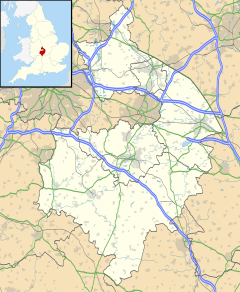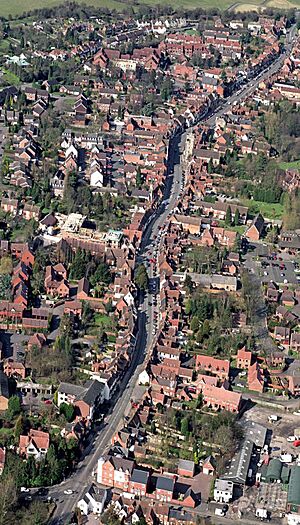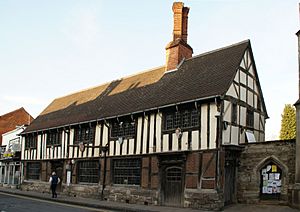Henley-in-Arden facts for kids
Quick facts for kids Henley-in-Arden |
|
|---|---|
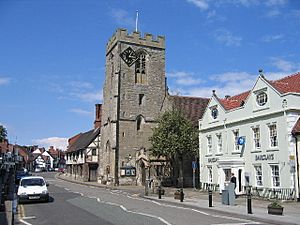 High Street |
|
| Population | 1,828 (parish 2021) 3,000 (built-up area 2021) |
| OS grid reference | SP1566 |
| Civil parish |
|
| District |
|
| Shire county | |
| Region | |
| Country | England |
| Sovereign state | United Kingdom |
| Post town | HENLEY-IN-ARDEN |
| Postcode district | B95 |
| Dialling code | 01564 |
| Police | Warwickshire |
| Fire | Warwickshire |
| Ambulance | West Midlands |
| EU Parliament | West Midlands |
| UK Parliament |
|
Henley-in-Arden, often called Henley, is a historic market town in Warwickshire, England. It's part of the Stratford-on-Avon District. Its name comes from the ancient Forest of Arden that once covered this area.
Henley is famous for its many old buildings, some from the Middle Ages. You can see lots of different building styles here. The main street, called High Street, is about one mile (1.6 km) long. It's a special 'conservation area' to protect its history. In 2021, about 1,828 people lived in Henley-in-Arden itself. If you include the nearby area of Beaudesert, the population was around 3,000.
Contents
Where is Henley-in-Arden Located?
Henley-in-Arden is in the middle of England. It's about 9 miles (14 km) west of Warwick, which is the county town. It's also about 15 miles (24 km) southeast of Birmingham and 9 miles (14 km) north of Stratford-upon-Avon. The road between Stratford and Henley is even named Henley Street!
The town sits in the valley of the River Alne. This river separates Henley from its close neighbor, Beaudesert. Henley and Beaudesert are so close they act like one town. They even share a local council, even though Beaudesert is technically a separate area.
Henley is at a busy crossroads of the A3400 and A4189 roads. It's also the starting point for the circular Arden Way walking path. Another path, the Heart of England Way, also goes through the town. There's a special nature reserve called Henley Sidings nearby, which is looked after by the Warwickshire Wildlife Trust.
A Look at Henley's History
Henley-in-Arden isn't mentioned in the old Domesday Book from the 11th century. This suggests it might not have existed until the 1100s. The first time we see Henley mentioned in official papers is during the time of King Henry II. It started as a small village, or hamlet, connected to Wootton Wawen. It was on an old road that led out of the Forest of Arden.
How Henley Became a Market Town
In the 11th century, a man named Thurstan de Montfort built Beaudesert Castle on a hill near Beaudesert. This was a "motte and bailey" castle, meaning it had a mound (motte) and a walled courtyard (bailey). In 1140, the Empress Matilda gave permission for a market to be held at the castle. Because of this, Henley quickly grew into a busy market town. It was in a great spot on the main road between Birmingham and Stratford.
Later, in 1220, the local lord, Peter de Montfort, got permission from King Henry III for Henley to have a weekly market every Monday. He also got permission for a two-day annual fair.
Challenges and Growth
Henley's early success faced a setback in 1265 during the Second Barons' War. Peter de Montfort died fighting in a battle, and the king's forces burned the town and castle as punishment. But Henley recovered! By 1296, it had become a borough, which is a town with special rights. In 1315, all the people living in Henley were recorded as "freemen," meaning they had more rights than others.
In 1324, the King himself stayed at Beaudesert Castle for a week. By 1336, the market was so successful that the people of Henley got permission from King Edward III to charge a small tax on goods sold there. This money was used to pave the streets, making them much better!
During the Hundred Years' War, in 1346, the lord of the manor, Peter de Montfort, sent 160 archers from Warwickshire to the famous Battle of Crecy. Later, in the 15th century, the Boteler family became the lords of Henley. In 1449, Ralph Boteler, 1st Baron Sudeley got a new charter from King Henry VI. This confirmed the right to hold a weekly market and two annual fairs.
Henley faced more trouble during the English Civil War. In 1643, Prince Rupert, who led the Royalist army, marched his soldiers through the town. They took many things from the area as they passed through on their way to Birmingham.
Local Government in the Past
Because Henley was a market town without a royal charter, its local government was run by a "manorial court." This court was led by the lord of the manor. Below him were officials like a high bailiff, a low bailiff, and a constable. There were also people who checked ale, leather, and fields. These officials were chosen every year. They would also help open the annual town fair. The town's meeting place, the Guild Hall, was inherited from a medieval Guild.
Records from these courts show they dealt with everyday problems. For example, they tried to stop poor people from moving into town. They also dealt with loose pigs and horses parked in the streets.
Travel and Transport

Henley-in-Arden railway station is on the North Warwickshire Line. You can catch regular trains from here to Birmingham Moor Street, Birmingham Snow Hill, and Stratford-upon-Avon.
The town is also just a few miles southwest of the M40 motorway. This big road connects Birmingham to London.
If you prefer buses, the X20 service runs through Henley. It goes from Stratford-upon-Avon to Solihull along the High Street. This bus runs about every 60 minutes.
News and Media
For local news and TV shows, people in Henley can watch BBC West Midlands and ITV Central. These channels get their signals from nearby TV transmitters.
There are also many local radio stations. These include BBC CWR, Capital Mid-Counties, and Heart West Midlands.
The town's local newspapers are the Stratford Observer and Stratford Herald.
Schools in Henley
Henley-in-Arden has several schools. These include Henley-in-Arden Montessori Primary School and Henley-In-Arden CE Primary School. For older students, there is Henley-in-Arden School and Venture Academy. There is also St Mary's RC Primary School.
Famous People from Henley
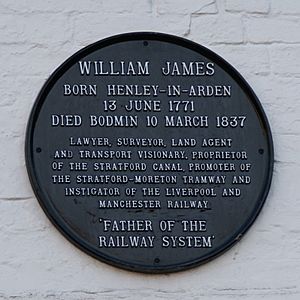
- Benjamin Beddome (1717–1795): He was a hymn writer, born in Henley. Many of his hymns are still used today.
- Keble Howard (1875–1928): This was the pen name of John Keble Bell. He was an author and journalist who grew up in Henley. His father was the local vicar.
- William James (1771–1837): He was a pioneer in promoting railways and was born in Henley.
See also
 In Spanish: Henley-in-Arden para niños
In Spanish: Henley-in-Arden para niños


